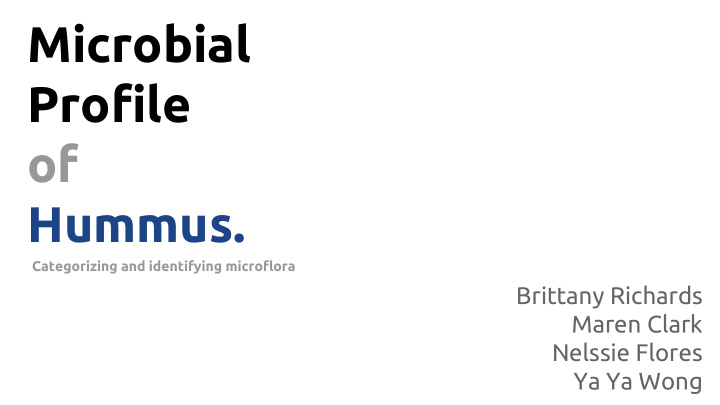



Microbial Profile of Hummus. Categorizing and identifying microflora Brittany Richards Maren Clark Nelssie Flores Ya Ya Wong
Our Project. Happy Monkey Hummus is a local company dedicated to the creation of wholesome, organic hummus made with sustainable and locally grown ingredients and without the use of artificial preservatives. Problem: Shelf life Question: Microbial flora present in hummus? A series of microbial tests were performed with the objective of categorizing and identifying microflora
Method - Enumeration. ● Samples ○ A: Original ○ B: Fire Roasted Bell Pepper ○ C: Pura Vida ● Tests ○ Coliform ○ Yeast and Mold ○ Aerobic Plate Count (APC) ○ Mesophilic Aerobic Spore (MAS) Test
Method - Enumeration. ● Mesophilic Aerobic Spore Test (MAS) ○ Tryptone glucose extract (TGE) agar ○ Flasks held in water bath (80˚C) for 30 minutes ■ activates spores ○ Pour plates
Method - Identification. Colonies from APC (4) Colonies from TGE (2) Categorized Identification Dr. Robison’s Lab Gram Stain Microbial identification system Morphology (MIS) whole cell fatty acid analysis via gas chromatography (This method was also used in Dr. Steele’s paper on corn masa)
Results. week 0 20 30 25 17 20 10 Original Bell Pepper Pura Vida
Results. week 1 60 29 40 27 11 Original Bell Pepper Pura Vida
Results. week 2 180 100 39 18 15 Original Bell Pepper Pura Vida
Results. week 3 Problems with autoclave
Results. week 4 90 40 5 7 10 Original Bell Pepper Pura Vida
Results.
Categorizing of Bacteria. Gram Staining Results of Original APC Colonies Colony appearance Gram Stain Results A - Gram negative and positive A - perfect circle, creamy, rings, bacillus possibly encapsulated uniform color B - Gram negative diplobacilli B - spheres, creamy, flat C - Gram positive streptococci C - circular and jagged edges D - Gram positive diplococci D - cloudy, circular
Identification of Bacteria. Current Results: Microbacterium barkeri Family: Microbacteriaceae is a family of bacteria of the order Actinomycetales. Genera: Microbacterium They are Gram-positive rods. Frequently isolated from soil.
Identification of Bacteria. Current Results: Micrococcus lylae Family: Micrococcaceae is a family of bacteria of the order Actinomycetales Genera: Micrococcus They are Gram-positive spheres. Frequently isolated from soil, water, and dust.
Discussion- Coliforms, Yeast and Mold ● Competition ● pH ○ <4.0 ● Process temperature ○ Cook beans, add dry ingredients held 180˚F for 10-15 minutes.
Discussion - APC. ● Most growth in Sample A (Original) ○ Least ingredients Antimicrobial effects of red bell ○ peppers (Sample B) Antimicrobial effects of spices ○ (Sample C) ● Sample A and B growth starts to decline at week 4 outcompeting of microorganisms ○ ○ liquefying gel of Petrifilm APC plates ■ inaccurate count
Discussion - Mesophilic Aerobic Sporeformers ● Why decreased? - reverting of the activated spores to ● Tahini dormant form under 40 ˚F - from sesame ● Why increased? - sesame grow close to superdormant Bacillus the soil spores -made in developing - higher moist-heat resistance countries (Jordan) - recover from heat stress injuries during refrigeration
Conclusion. ● Inhibitory effects of various spices was efficient ● Using our research and identifications, company can further determine shelf life ● More research to be done
References. 2010-03, Hazard Analysis and Critical Control Point Generic Models for Some Trad Allahghadri, T., Rasooli, I., Owlia, P., Nadooshan, M. J., Ghazanfari, T., Taghizadeh, M. and Astaneh, S. D. A. (2010), Antimicrobial Property, Antioxidant Capacity, and Cytotoxicity of Essential Oil from Cumin Produced in Iran. Journal of Food Science, 75: H54–H61. doi: 10.1111/j.1750-3841.2009.01467.x Rodriguez-Palacios, A., LeJeune, T.J. (2011), Moist-Heat Resistance, Spore Aging, and Superdormancy in Clostriduim difficile in American Society for Microbiology, May 2011 vol. 77 no. 9 3085-3091 Amaeze, N.J. (2013), Effect of different fruit components, aeration and cold storage at 5°C on the germination of ascospores of Neosartorya fischeri . Letters in Applied Microbiology, 56: 443–448. doi: 10.1111/lam.12072 Ghosh S., Setlow P. 2009. Isolation and characterization of superdormant spores of Bacillus species. J. Bacteriol. 191: 1787–1797.
Questions?
Thank you
Recommend
More recommend